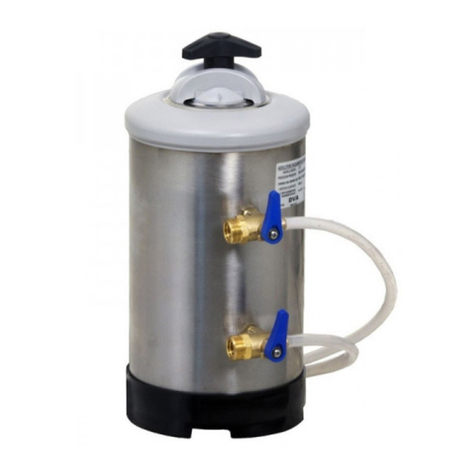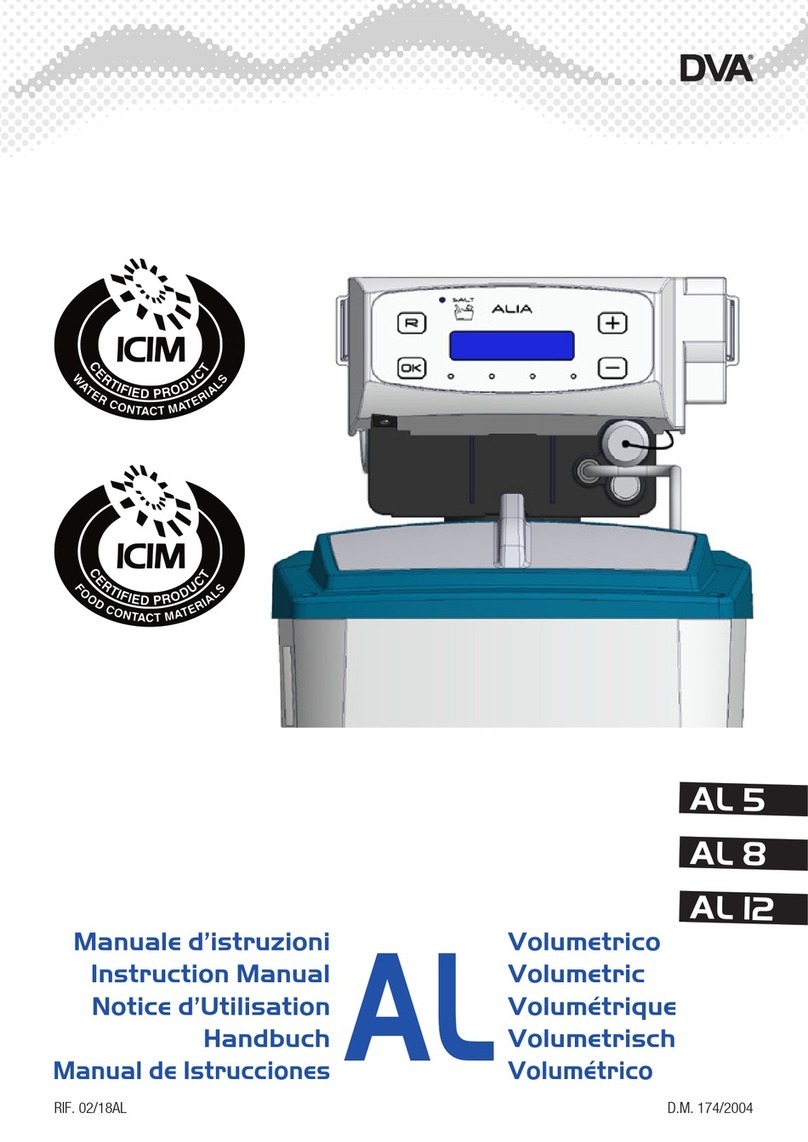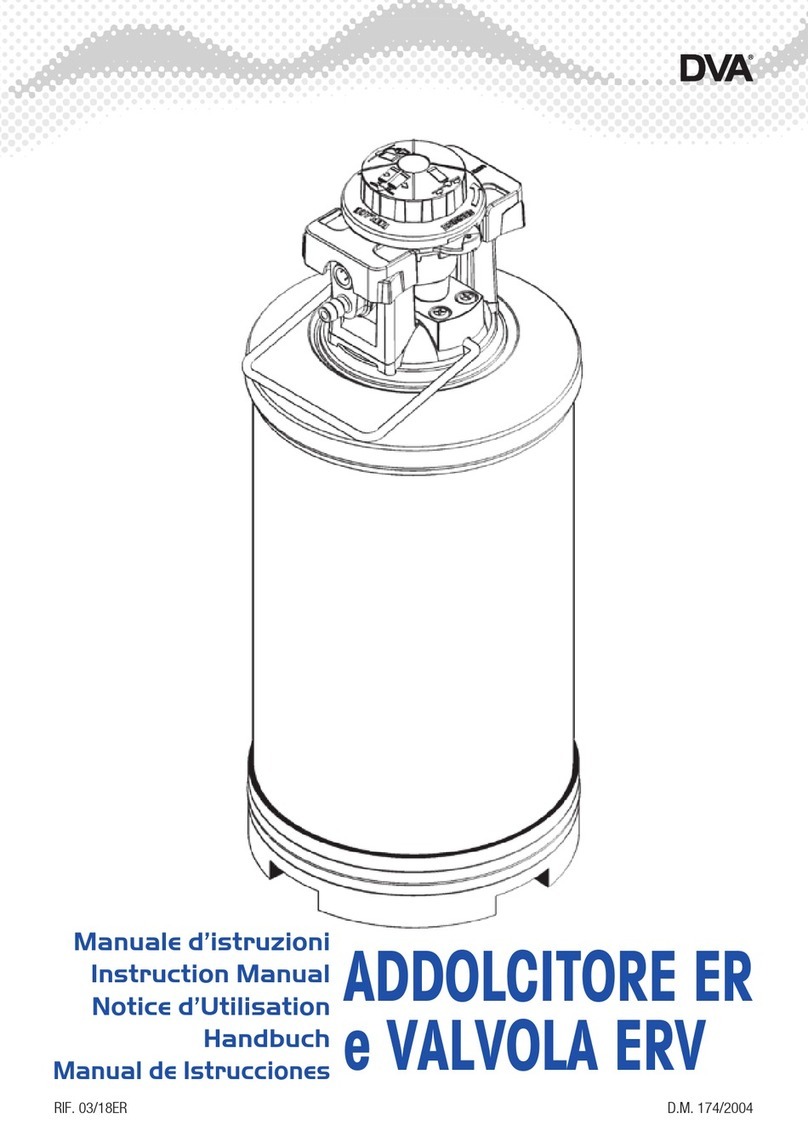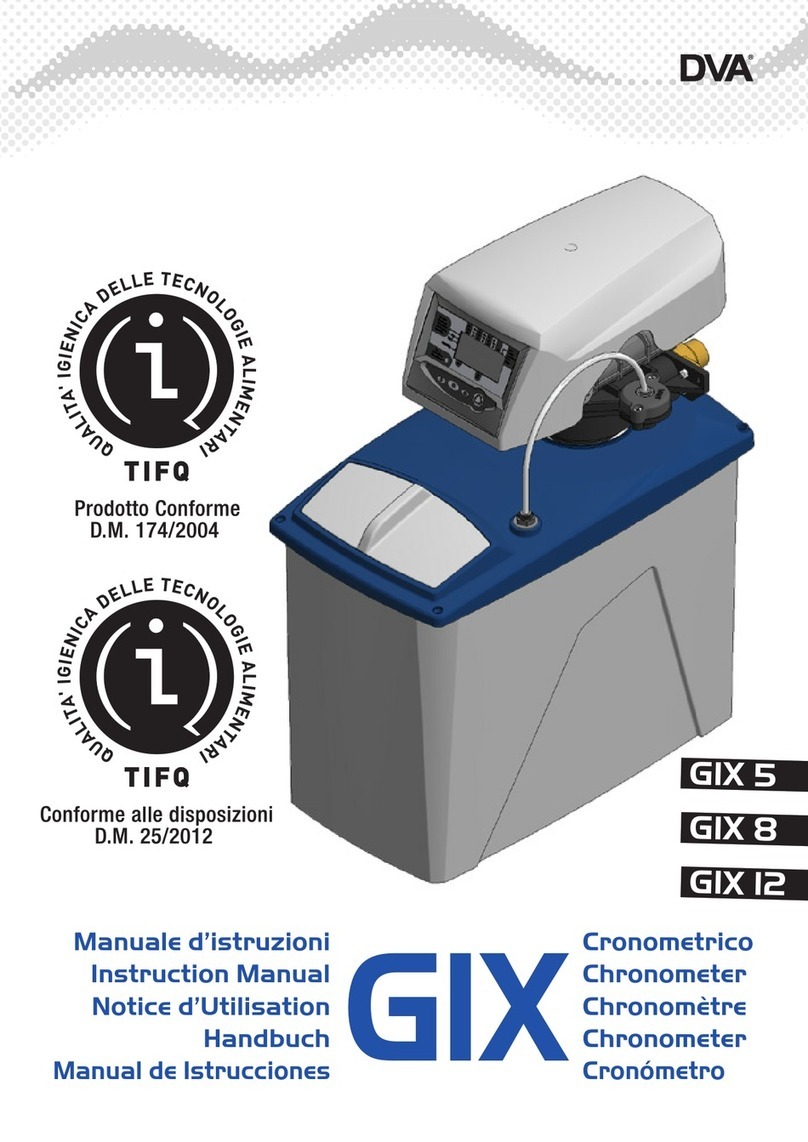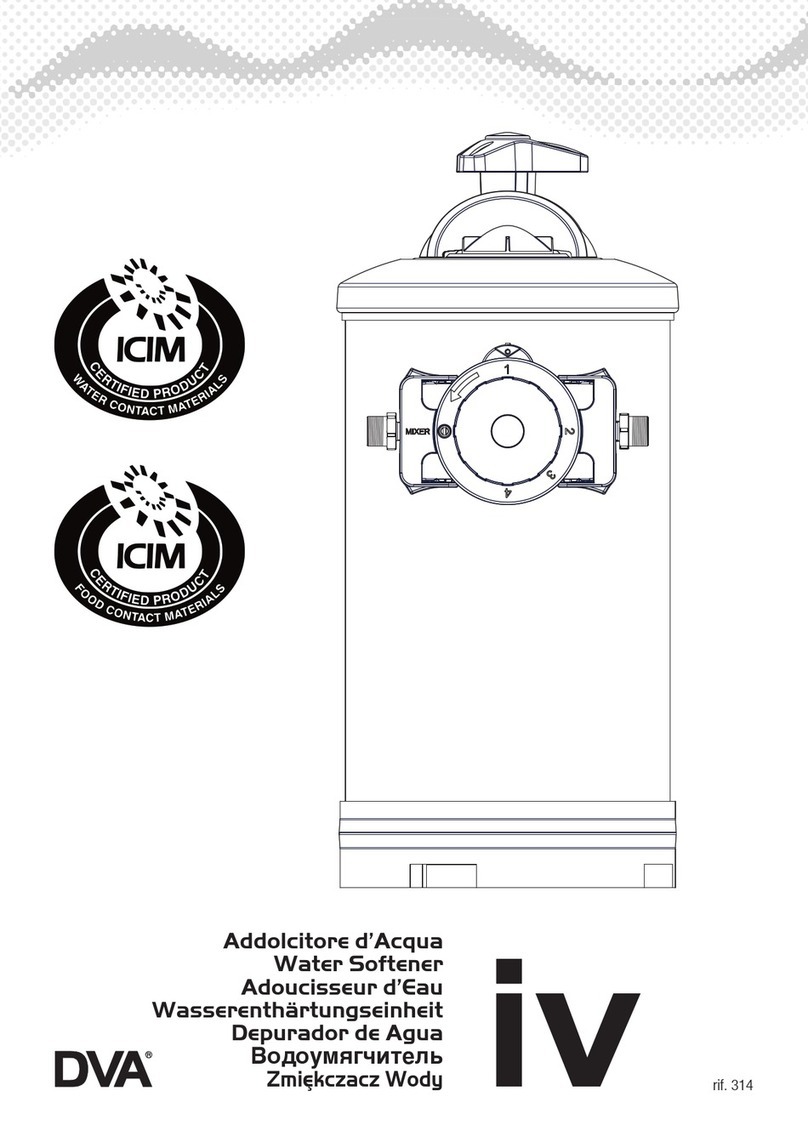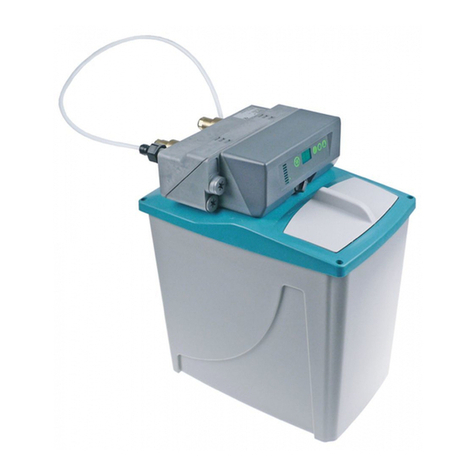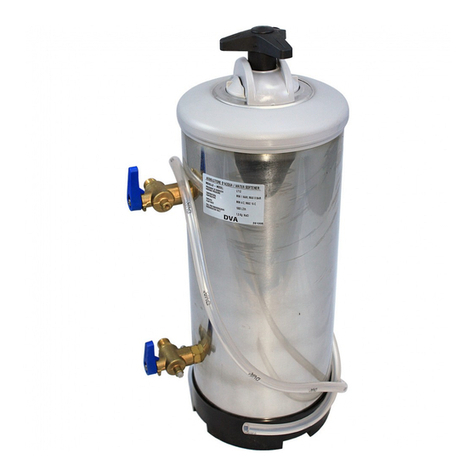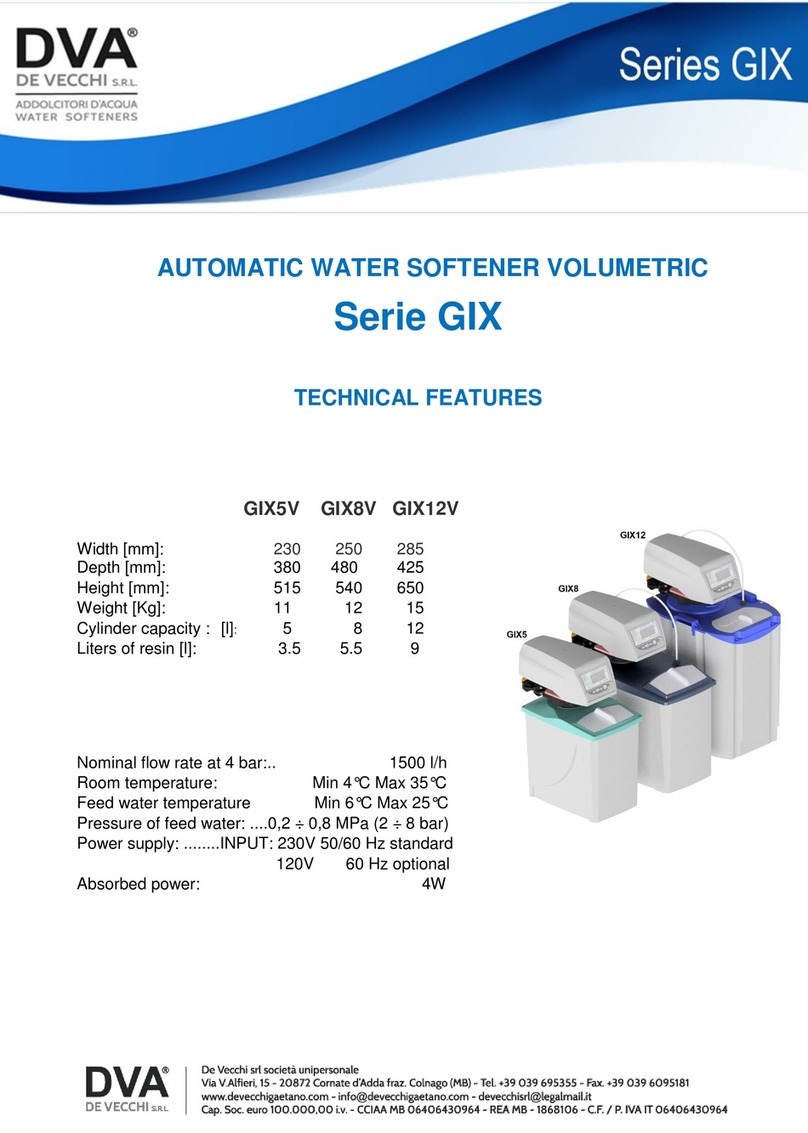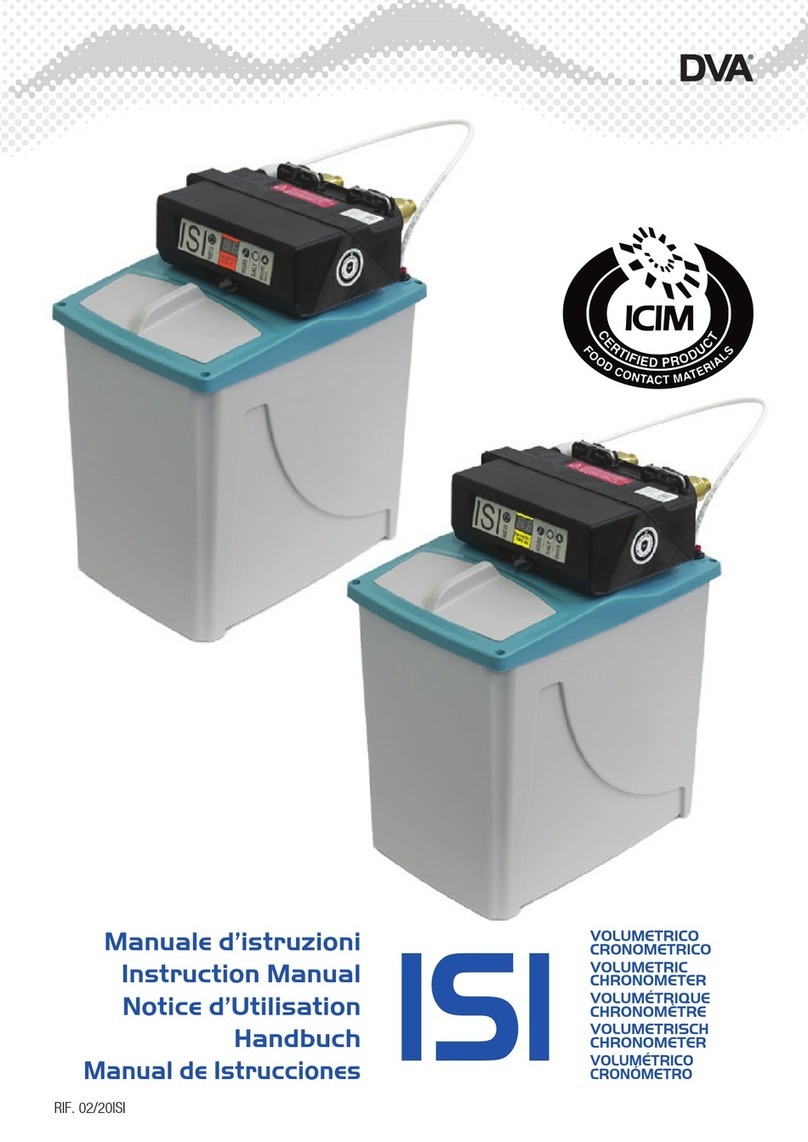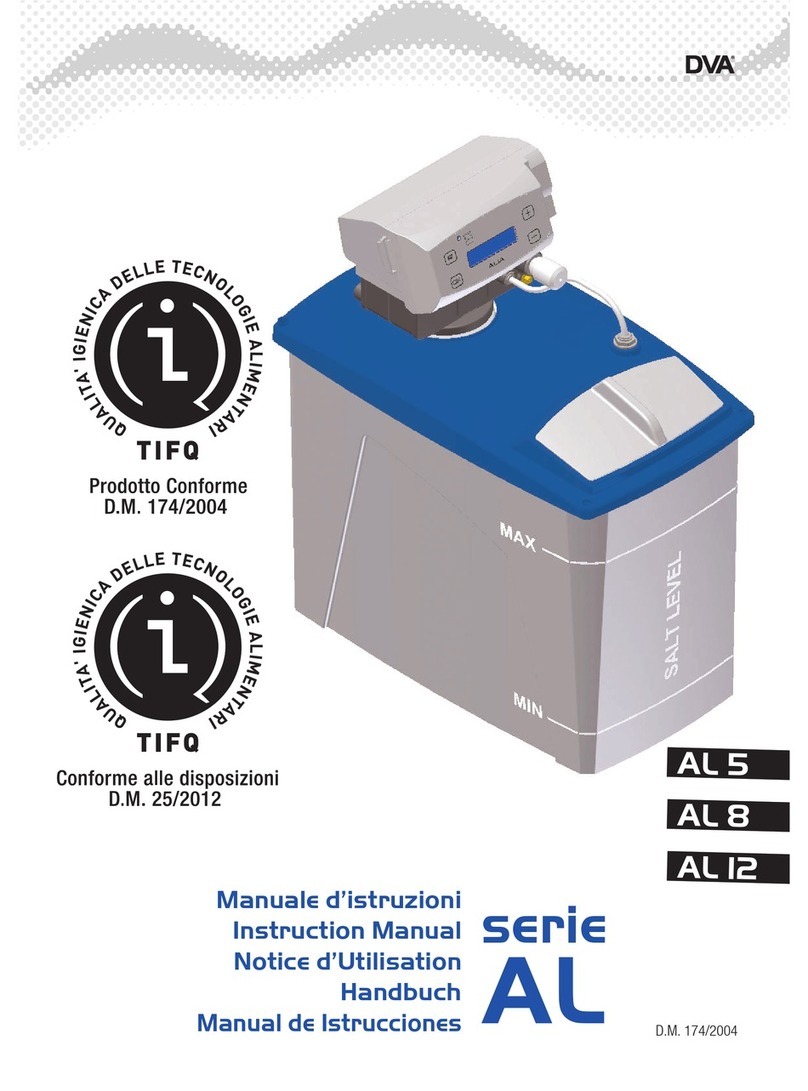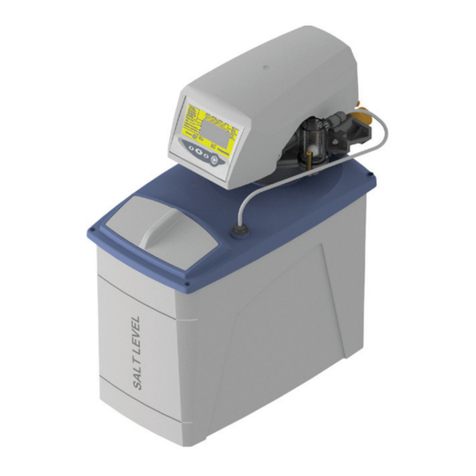
8Manuale d’istruzioni serie AL
manuale
d’istruzioni serie AL ITALIANO
9. L’addolcitore garantisce esclusivamente l’addolcimento
dell’acqua potabile fredda, ogni altro uso è da considerarsi
irragionevole.
7) AVVERTENZE PER L’INSTALLATORE
1. Aprire la confezione ed assicurarsi che l’apparecchio
non sia danneggiato; eventuali danni subiti nel trasporto
vanno segnalati al rivenditore.
2. Conservare per qualche tempo la scatola dell’imballo
avendo cura di non lasciare pezzi dell’imballo pericolosi o
piccoli alla portata dei bambini.
3. Installare l’apparecchio in un luogo asciutto e facilmente
accessibile per le operazioni di manutenzione e pulizia,
non installare la macchina in posti sporchi o in cui sia
difficile fare pulizia.
4. Non installare in ambienti in cui c’è un evidente violazio-
ne delle norme di sicurezza elettrica o antinfortunistica.
5. La macchina deve essere installata in posizione orizzon-
tale.
6. Per la pulizia della macchina usare uno straccio asciutto
o leggermente umido.
7. Tenere lontano dai prodotti acidi o corrosivi.
8. Verificare la corretta messa a terra dell’impianto elettri-
co.
9. Verificare che la temperatura dell’ambiente dove si in-
stalla la macchina sia compresa tra 4°C e 35°C.
10. Verificare che il prelievo dell’acqua avvenga da una tuba-
zione dove scorre acqua ad uso umano.
11. Nel caso fosse necessario predisporre un by-pass per
evitare interruzioni d’acqua in caso di fermo macchina.
12. Prevedere un rubinetto per il prelievo dell’acqua in usci-
ta, per il controllo della durezza.
13. Predisporre l’impianto elettrico, idrico e di scarico per
una corretta installazione, in particolare controllare che
tutti i tubi siano liberi e non schiacciati o con strozzature.
14. Si consiglia di installare prima della macchina un filtro
per la filtrazione dell’acqua in ingresso.
15. Nel caso in cui l’addolcitore sia vicino ad una caldaia,
assicurarsi che non vi sia un eccessivo riscaldamento
dei tubi e dell’addolcitore stesso; mantenere se possibile,
alcuni metri di distanza di tubazione (almeno 3 m) tra
l’uscita dell’addolcitore e l’ingresso della caldaia;
16. Accertarsi che la pressione massima di rete non superi
0.8 Mpa (8 bar), in caso contrario installare un riduttore
di pressione.
La ditta produttrice non è responsabile di eventuali danni
e/o infortuni che possano derivare dalla mancata osser-
vanza di queste precauzioni.
8) RACCORDI RAPIDI
Le connessioni dei tubi con la valvola sono realizzate con
attacchi rapidi.
Per scollegare un tubo occorre scaricare la pressione, quindi
premere l’anello nero che lo circonda in prossimità dell’inseri-
mento, dopo di che sfilare il tubo (fig. 10).
Per ricollegarlo occorre inserirlo fino in battuta.
9) INSTALLAZIONE
9.1 COLLEGAMENTO ALLA RETE ELETTRICA
Assicurarsi che il voltaggio della rete elettrica sia compatibile
con quello della macchina.
Verificare la compatibilità tra la spina elettrica e la presa elet-
trica, in caso di incompatibilità farla sostituire da personale
qualificato, che accerterà anche se la sezione dei cavi sia
idonea alla potenza assorbita.
L’apparecchio è costruito conforme ai requisiti essenziali di
sicurezza prescritti dalle direttive Europee:
Direttiva Bassa Tensione 2006/95/CE
Direttiva Compatibilità Elettromagnetica 2004/108/CE
norme: EN 55014-1 (2006)+A1+A2, EN 55014-2
(1997)+A1+A2, EN 61000-3-2 (2006)+A1+A2, EN 61000-
3-3 (2008)
Norma di prodotto IEC/EN 60335-1:2010
per la Sicurezza degli apparecchi elettrici di uso domestico
e similari
Utilizza componenti omologati UL/CSA/VDE
È conforme alla normativa RoHS
L’installazione deve essere conforme alla norma impianti
elettrici CEI 64.8.
9.2 COLLEGAMENTO ALLA RETE IDRICA
Il collegamento con la rete idrica deve essere fatto in ottempe-
ranza con le norme vigenti, secondo le istruzioni del produtto-
re e da personale qualificato.
Verificare che:
• i tubi d’entrata (fig. 3, G) e d’uscita (fig. 3, H) siano confor-
mi alle norme relative a “Tubi per acqua potabile”.
• il tubo d’entrata dell’acqua abbia un diametro interno di
almeno 8 mm.
• la pressione non sia inferiore a 0.2 Mpa (2 bar) o superiore
a 0.8 Mpa (8 bar) (si consiglia almeno 3 o 4 bar).
• nel caso la pressione superi gli 8 bar occorre installare un
riduttore di pressione.
Se la pressione è bassa ci posso essere anomalie di funzio-
namento.
Installare sul tubo d’uscita una valvola di non ritorno (fig. 3, A)
(DVGW, DIN 1988 T2), per preservare l’addolcitore da even-
tuali ritorni di acqua calda che potrebbero danneggiarlo.
Vi consigliamo l’installazione descritta nella fig. 3, perché vi
permetterà di utilizzare l’acqua nel vostro impianto, anche nel
caso in cui si debba fare manutenzione all’addolcitore.
Al termine dell’installazione, prima di aprire i rubinetti d’en-
trata e di uscita, leggere il capitolo 10 “messa in funzione”.
9.3 COLLEGAMENTO ALLA RETE DELLO SCARICO
L’acqua che uscirà dallo scarico durante la rigenerazione,
deve essere convogliata attraverso il tubo flessibile (fig. 3, F)
di plastica Ø8 mm (compreso nella confezione) nello scarico
più vicino.
Installare il tubo di scarico leggendo le seguenti indicazioni,
una scorretta installazione causerà mal funzionamenti:
inserire il tubo di scarico nell’apposito alloggiamento (fig. 2,
drain) e posizionare il tubo in un pozzetto facendo attenzione
che:
• se il punto di scarico è situato più in alto, è consentita
un’altezza massima di 1,8 metri a condizione che il tubo
non superi i 5 metri di lunghezza e la pressione della rete
sia di almeno 3 bar (fig. 5);
• accertarsi che il tubo non venga schiacciato o piegato,
l’acqua al suo interno deve scorrere senza ostacoli (fig. 4,
A);
• non collegare il tubo di scarico direttamente ad un sifone
o ad altre tubazioni di scarico, per evitare ritorni o inquina-
menti nell’addolcitore.
9.4 COLLEGAMENTO ALLA SALAMOIA
L’installatore deve controllare che il tubo ed i raccordi di col-
legamento tra la valvola e la salamoia abbiano una perfetta
tenuta, per evitare infiltrazioni d’aria (fig. 7, A).






